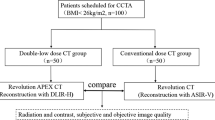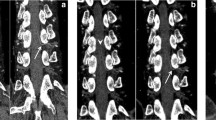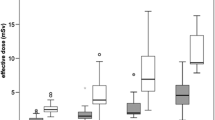Abstract
Objectives
To further reduce the contrast medium (CM) dose of full aortic CT angiography (ACTA) imaging using the augmented cycle-consistent adversarial framework (Au-CycleGAN) algorithm.
Methods
We prospectively enrolled 150 consecutive patients with suspected aortic disease. All received ACTA scans of ultra-low-dose CM (ULDCM) protocol and low-dose CM (LDCM) protocol. These data were randomly assigned to the training datasets (n = 100) and the validation datasets (n = 50). The ULDCM images were reconstructed by the Au-CycleGAN algorithm. Then, the AI-based ULDCM images were compared with LDCM images in terms of image quality and diagnostic accuracy.
Results
The mean image quality score of each location in the AI-based ULDCM group was higher than that in the ULDCM group but a little lower than that in the LDCM group (all p < 0.05). All AI-based ULDCM images met the diagnostic requirements (score ≥ 3). Except for the image noise, the AI-based ULDCM images had higher attenuation value than the ULDCM and LDCM images as well as higher SNR and CNR in all locations of the aorta analyzed (all p < 0.05). Similar results were also seen in obese patients (BMI > 25, all p < 0.05). Using the findings of LDCM images as the reference, the AI-based ULDCM images showed good diagnostic parameters and no significant differences in any of the analyzed aortic disease diagnoses (all K-values > 0.80, p < 0.05).
Conclusions
The required dose of CM for full ACTA imaging can be reduced to one-third of the CM dose of the LDCM protocol while maintaining image quality and diagnostic accuracy using the Au-CycleGAN algorithm.
Key Points
• The required dose of contrast medium (CM) for full ACTA imaging can be reduced to one-third of the CM dose of the low-dose contrast medium (LDCM) protocol using the Au-CycleGAN algorithm.
• Except for the image noise, the AI-based ultra-low-dose contrast medium (ULDCM) images had better quantitative image quality parameters than the ULDCM and LDCM images.
• No significant diagnostic differences were noted between the AI-based ULDCM and LDCM images regarding all the analyzed aortic disease diagnoses.




Similar content being viewed by others
Change history
15 November 2022
A Correction to this paper has been published: https://doi.org/10.1007/s00330-022-09169-5
Abbreviations
- ACTA:
-
Aortic CT angiography
- AI:
-
Artificial intelligence
- ASIR-V:
-
Adaptive statistical iterative reconstruction-V
- Au-CycleGAN:
-
Augmented cycle-consistent adversarial framework
- BMI :
-
Body mass index
- CNR:
-
Contrast-to-noise ratio
- DLIR:
-
Deep learning image reconstruction
- LDCM:
-
Low-dose contrast medium
- SNR:
-
Signal-to-noise ratio
- ULDCM:
-
Ultra-low-dose contrast medium
References
Erbel R, Aboyans V, Boileau C et al (2014) 2014 ESC guidelines on the diagnosis and treatment of aortic diseases: document covering acute and chronic aortic diseases of the thoracic and abdominal aorta of the adult. The Task Force for the Diagnosis and Treatment of Aortic Diseases of the European Society of Cardiology (ESC). Eur Heart J 35:2873–2926
Knuuti J, Bengel F, Bax JJ et al (2014) Risks and benefits of cardiac imaging: an analysis of risks related to imaging for coronary artery disease. Eur Heart J 35:633–638
Masuda T, Funama Y, Nakaura T et al (2018) Radiation dose reduction with a low-tube voltage technique for pediatric chest computed tomographic angiography based on the contrast-to-noise ratio index. Can Assoc Radiol J 69:390–396
Lenga L, Albrecht MH, Othman AE et al (2017) Monoenergetic dual-energy computed tomographic imaging: cardiothoracic applications. J Thorac Imaging 32:151–158
Benz DC, Grani C, Hirt Moch B et al (2016) Minimized radiation and contrast agent exposure for coronary computed tomography angiography: first clinical experience on a latest generation 256-slice scanner. Acad Radiol 23:1008–1014
Albrecht MH, De Cecco CN, Schoepf UJ et al (2018) Dual-energy CT of the heart current and future status. Eur J Radiol 105:110–118
Schmidt B, Flohr T (2020) Principles and applications of dual source CT. Phys Med 79:36–46
Kahn CE Jr (2017) From images to actions: opportunities for artificial intelligence in radiology. Radiology 285:719–720
Anthimopoulos M, Christodoulidis S, Ebner L, Christe A, Mougiakakou S (2016) Lung pattern classification for interstitial lung diseases using a deep convolutional neural network. IEEE Trans Med Imaging 35:1207–1216
Baskaran L, Maliakal G, Al'Aref SJ et al (2020) Identification and quantification of cardiovascular structures from CCTA: an end-to-end, rapid, pixel-wise, deep-learning method. JACC Cardiovasc Imaging 13:1163–1171
Zhang N, Yang G, Zhang W et al (2021) Fully automatic framework for comprehensive coronary artery calcium scores analysis on non-contrast cardiac-gated CT scan: total and vessel-specific quantifications. Eur J Radiol 134:109420
van Velzen SGM, Lessmann N, Velthuis BK et al (2020) Deep learning for automatic calcium scoring in CT: validation using multiple cardiac CT and chest CT protocols. Radiology 295:66–79
Nakanishi R, Slomka PJ, Rios R et al (2021) Machine learning adds to clinical and CAC assessments in predicting 10-year CHD and CVD deaths. JACC Cardiovasc Imaging 14:615–625
Eisenberg E, McElhinney PA, Commandeur F et al (2020) Deep learning-based quantification of epicardial adipose tissue volume and attenuation predicts major adverse cardiovascular events in asymptomatic subjects. Circ Cardiovasc Imaging 13:e009829
Yang Q, Yan P, Zhang Y et al (2018) Low-dose CT image denoising using a generative adversarial network with Wasserstein distance and perceptual loss. IEEE Trans Med Imaging 37:1348–1357
Greffier J, Hamard A, Pereira F et al (2020) Image quality and dose reduction opportunity of deep learning image reconstruction algorithm for CT: a phantom study. Eur Radiol 30:3951–3959
Benz DC, Benetos G, Rampidis G et al (2020) Validation of deep-learning image reconstruction for coronary computed tomography angiography: impact on noise, image quality and diagnostic accuracy. J Cardiovasc Comput Tomogr 14:444–451
Brady SL, Kaufman RA (2012) Investigation of American Association of Physicists in Medicine Report 204 size-specific dose estimates for pediatric CT implementation. Radiology 265:832–840
Shrimpton PC, Hillier MC, Lewis MA, Dunn M (2006) National survey of doses from CT in the UK: 2003. Br J Radiol 79:968–980
Liu T, Gao Y, Wang H et al (2020) Association between right ventricular strain and outcomes in patients with dilated cardiomyopathy. Heart. https://doi.org/10.1136/heartjnl-2020-317949
Nwabuo CC, Moreira HT, Vasconcellos HD et al (2019) Left ventricular global function index predicts incident heart failure and cardiovascular disease in young adults: the coronary artery risk development in young adults (CARDIA) study. Eur Heart J Cardiovasc Imaging 20:533–540
Karnik AA, Gopal DM, Ko D, Benjamin EJ, Helm RH (2019) Epidemiology of atrial fibrillation and heart failure: a growing and important problem. Cardiol Clin 37:119–129
Januzzi JL Jr, Prescott MF, Butler J et al (2019) Association of change in N-terminal pro-B-type natriuretic peptide following initiation of sacubitril-valsartan treatment with cardiac structure and function in patients with heart failure with reduced ejection fraction. JAMA 322:1085–1095
Desai AS, Solomon SD, Shah AM et al (2019) Effect of sacubitril-valsartan vs enalapril on aortic stiffness in patients with heart failure and reduced ejection fraction: a randomized clinical trial. JAMA 322:1077–1084
Stewart MH, Lavie CJ, Shah S et al (2018) Prognostic implications of left ventricular hypertrophy. Prog Cardiovasc Dis 61:446–455
Liu T, Song D, Dong J et al (2017) Current understanding of the pathophysiology of myocardial fibrosis and its quantitative assessment in heart failure. Front Physiol 8:238
Ippolito D, Talei Franzesi C, Fior D, Bonaffini PA, Minutolo O, Sironi S (2015) Low kV settings CT angiography (CTA) with low dose contrast medium volume protocol in the assessment of thoracic and abdominal aorta disease: a feasibility study. Br J Radiol 88:20140140
Wei L, Li S, Gao Q, Liu Y, Ma X (2016) Use of low tube voltage and low contrast agent concentration yields good image quality for aortic CT angiography. Clin Radiol 71:1313 e1315-1313 e1310
Piechowiak EI, Peter JF, Kleb B, Klose KJ, Heverhagen JT (2015) Intravenous iodinated contrast agents amplify DNA radiation damage at CT. Radiology 275:692–697
Geyer LL, Schoepf UJ, Meinel FG et al (2015) State of the art: iterative CT reconstruction techniques. Radiology 276:339–357
Johansen CB, Martinsen ACT, Enden TR, Svanteson M (2022) The potential of iodinated contrast reduction in dual-energy CT thoracic angiography; an evaluation of image quality. Radiography (Lond) 28:2–7
Albrecht MH, Trommer J, Wichmann JL et al (2016) Comprehensive comparison of virtual monoenergetic and linearly blended reconstruction techniques in third-generation dual-source dual-energy computed tomography angiography of the thorax and abdomen. Invest Radiol 51:582–590
Yi Y, Zhao XM, Wu RZ et al (2019) Low dose and low contrast medium coronary CT angiography using dual-layer spectral detector CT. Int Heart J 60:608–617
Park C, Choo KS, Jung Y, Jeong HS, Hwang JY, Yun MS (2021) CT iterative vs deep learning reconstruction: comparison of noise and sharpness. Eur Radiol 31:3156–3164
Sun J, Li H, Gao J et al (2021) Performance evaluation of a deep learning image reconstruction (DLIR) algorithm in “double low” chest CTA in children: a feasibility study. Radiol Med 126:1181–1188
Haubold J, Hosch R, Umutlu L et al (2021) Contrast agent dose reduction in computed tomography with deep learning using a conditional generative adversarial network. Eur Radiol 31:6087–6095
Hagan PG, Nienaber CA, Isselbacher EM et al (2000) The International Registry of Acute Aortic Dissection (IRAD): new insights into an old disease. JAMA 283:897–903
Parker MS, Matheson TL, Rao AV et al (2001) Making the transition: the role of helical CT in the evaluation of potentially acute thoracic aortic injuries. AJR Am J Roentgenol 176:1267–1272
Quint LE, Francis IR, Williams DM et al (1996) Evaluation of thoracic aortic disease with the use of helical CT and multiplanar reconstructions: comparison with surgical findings. Radiology 201:37–41
Einstein AJ, Weiner SD, Bernheim A et al (2010) Multiple testing, cumulative radiation dose, and clinical indications in patients undergoing myocardial perfusion imaging. JAMA 304:2137–2144
Acknowledgements
We are grateful to all the staff and epidemiologists who were involved in the care of our study subjects.
Funding
This study has received funding from the National Natural Science Foundation of China (82271986, U1908211), the Capital’s Funds for Health Improvement and Research Foundation of China (2020-1-1052), and the National Key Research and Development Program of China (2016YFC1300300).
Author information
Authors and Affiliations
Corresponding author
Ethics declarations
Guarantor
The scientific guarantor of this publication is Lei Xu.
Conflict of interest
The authors of this manuscript declare no relationships with any companies whose products or services may be related to the subject matter of the article.
Statistics and biometry
One of the authors (Nan Zhang) has significant statistical expertise.
Informed consent
Written informed consent was obtained from all subjects (patients) in this study.
Ethical approval
Institutional Review Board approval was obtained.
Methodology
• prospective
• diagnostic or prognostic study
• performed at one institution
Additional information
Publisher’s note
Springer Nature remains neutral with regard to jurisdictional claims in published maps and institutional affiliations.
The original online version of this article was revised: the funding information was corrected.
Supplementary Information
ESM 1
(DOCX 374 kb)
Rights and permissions
Springer Nature or its licensor (e.g. a society or other partner) holds exclusive rights to this article under a publishing agreement with the author(s) or other rightsholder(s); author self-archiving of the accepted manuscript version of this article is solely governed by the terms of such publishing agreement and applicable law.
About this article
Cite this article
Zhou, Z., Gao, Y., Zhang, W. et al. Artificial intelligence–based full aortic CT angiography imaging with ultra-low-dose contrast medium: a preliminary study. Eur Radiol 33, 678–689 (2023). https://doi.org/10.1007/s00330-022-08975-1
Received:
Revised:
Accepted:
Published:
Issue Date:
DOI: https://doi.org/10.1007/s00330-022-08975-1




